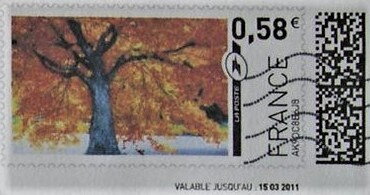Stamp: Tree in Autumn (France 2011)
Tree in Autumn (France 2011)
01 January (France ) within release MonTimbrEnLigne. Nature and Landscapes goes into circulation Stamp Tree in Autumn face value 0.58 Euro
| Stamp Tree in Autumn in catalogues | |
|---|---|
| Colnect codes: | Col: FR-TIM 2011-99 |
Stamp is square format.
Also in the issue MonTimbrEnLigne. Nature and Landscapes:
- Stamp - Tree in Autumn face value 0.58;
- Stamp - White Toadstools face value 0.58;
- Stamp - Earth 3 face value 0.95;
- Stamp - Chick just hatched from egg face value 0.58;
- Stamp - Forest Ride in the Snow in black face value 0.58;
- Stamp - Pink Maple Leaves face value 0.95;
- Stamp - Upland Meadow and Mountains face value 2.35;
- Stamp - Cherry Tree in black face value 0.58;
- Stamp - Hands holding large rosine coloured flower maybe a hibiscus face value 0.58;
- Stamp - Red Berries face value 0.60;
- Stamp - Cerise Primulas face value 58;
- Stamp - White Flowers 3 in black face value 0.58;
- Stamp - Green Forest face value 0.60;
|
Data entry completed
50%
|
|
|---|---|
| Stamp Tree in Autumn in digits | |
| Country: | France |
| Date: | 2011-01-01 |
| Perforation: | Simulated |
| Emission: | Personalized - Official |
| Format: | Stamp |
| Face Value: | 0.58 Euro |
Stamp Tree in Autumn it reflects the thematic directions:
utumn, also known as fall in North American English,is one of the four temperate seasons on Earth. Outside the tropics, autumn marks the transition from summer to winter, in September (Northern Hemisphere) or March (Southern Hemisphere). Autumn is the season when the duration of daylight becomes noticeably shorter and the temperature cools considerably. Day length decreases and night length increases as the season progresses until the winter solstice in December (Northern Hemisphere) and June (Southern Hemisphere). One of its main features in temperate climates is the striking change in colour for the leaves of deciduous trees as they prepare to shed.
In botany, a tree is a perennial plant with an elongated stem, or trunk, supporting branches and leaves in most species. In some usages, the definition of a tree may be narrower, including only woody plants with secondary growth, plants that are usable as lumber or plants above a specified height. Trees are not a taxonomic group but include a variety of plant species that have independently evolved a woody trunk and branches as a way to tower above other plants to compete for sunlight. In looser senses, the taller palms, the tree ferns, bananas and bamboos are also trees. Trees tend to be long-lived, some reaching several thousand years old. The tallest known tree, a coast redwood named Hyperion, stands 115.6 m (379 ft) high. Trees have been in existence for 370 million years. It is estimated that there are just over 3 trillion mature trees in the world. A tree typically has many secondary branches supported clear of the ground by the trunk. This trunk typically contains woody tissue for strength, and vascular tissue to carry materials from one part of the tree to another. For most trees it is surrounded by a layer of bark which serves as a protective barrier. Below the ground, the roots branch and spread out widely; they serve to anchor the tree and extract moisture and nutrients from the soil. Above ground, the branches divide into smaller branches and shoots. The shoots typically bear leaves, which capture light energy and convert it into sugars by photosynthesis, providing the food for the tree's growth and development. Flowers and fruit may also be present, but some trees, such as conifers, instead have pollen cones and seed cones; others, such as tree ferns, produce spores instead. Trees play a significant role in reducing erosion and moderating the climate. They remove carbon dioxide from the atmosphere and store large quantities of carbon in their tissues. Trees and forests provide a habitat for many species of animals and plants. Tropical rainforests are one of the most biodiverse habitats in the world. Trees provide shade and shelter, timber for construction, fuel for cooking and heating, and fruit for food as well as having many other uses. In parts of the world, forests are shrinking as trees are cleared to increase the amount of land available for agriculture. Because of their longevity and usefulness, trees have always been revered, with sacred groves in various cultures, and they play a role in many of the world's mythologies.


